Global Currency War Flash Points in the Middle East 'Age of Rage'
Economics / Middle East Mar 09, 2011 - 04:05 AM GMTBy: Gordon_T_Long
 The conflict in North Africa was a predictable outcome of the US Monetary Policy of Quantitative Easing. It is not plausible that the US Federal Reserve, as the manager of the world's Reserve Currency, did not fully recognize the global ramifications of such monetary inflation actions well in advance. Quantitative Easing like the Intercontinental Ballistic Missiles (ICBM) of the cold war era has had the same devastating pre-emptive impact on Libya.
The conflict in North Africa was a predictable outcome of the US Monetary Policy of Quantitative Easing. It is not plausible that the US Federal Reserve, as the manager of the world's Reserve Currency, did not fully recognize the global ramifications of such monetary inflation actions well in advance. Quantitative Easing like the Intercontinental Ballistic Missiles (ICBM) of the cold war era has had the same devastating pre-emptive impact on Libya.
There can also be little doubt that the bi-monthly meetings of the Bank of International Settlements (BIS) board of directors, which specifically meet to discuss coordinated monetary policy outcomes, did not consider this eventuality. The board of directors of this global power center includes all G7 Central Banks chiefs, with the conspicuous absence of a single member of the Arab League not receiving US military financial aid.
Our Process of Abstraction research methodology (shown below) has been signaling looming political conflict and social tensions for eighteen months. Our Tipping Points have proven once again to be surprisingly accurate predictors. Though Tunisia as an initial flash point was somewhat of a surprise, we knew it was going to soon emerge somewhere due to serious inflationary pressures injected into the global macro. As we will discuss, it is a direct result of the US policy of Quantitative Easing (QE) igniting global inflation in food and basic resources of survival. The social unrest this triggers is still in the early stages of what we call the "Age of Rage".
CONFLICT & TENSION - The "Age of Rage"
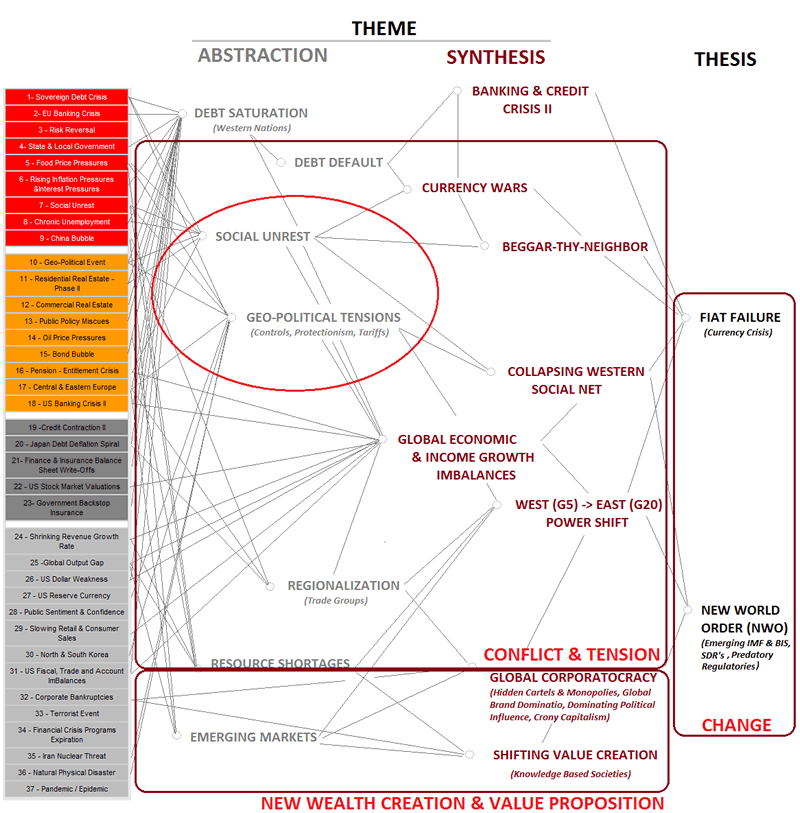
SOCIAL UNREST
The map below from the Economist shows the members of the Arab League. Starting with Tunisia's overthrow of the 23 year rule of Zine el-Abidine Ben Ali, the rage has spread like a wild fire through the Arab world. Egyptian protesters replaced President Hosni Mubarak in just 18 days, after 3 decades under his rule. More recently Algeria, Bahrain, Yemen, Jordan, and Libya have all seen major demonstrations by people fed up with the living standard they face on a daily basis. It appears to get worse and more deeply rooted each day.
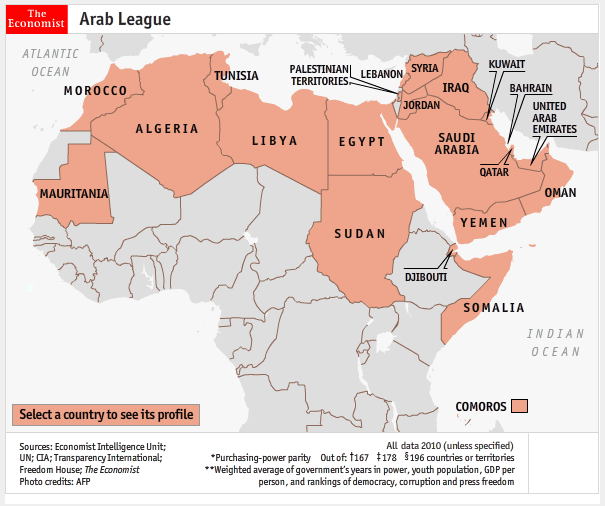
10% UNEMPLOYMENT THRESHOLD
Before we look below the headlines and media sound bites, it would be informative to step back and look at global unemployment rates. The chart below is based on the 'official' numbers as consolidated 01/2011 by BMGBullion.
I have drawn a vertical line at 10% unemployment as a reference point. What is quickly evident is that:
1- Countries above 10% unemployment have experienced significant and well documented social unrest, primarily because of poor economic conditions.
2- Countries in the range of 10% are presently reporting sporadic events that show borderline indicators of social unrest.
3- Countries with low unemployment are politically stable with minimal social tensions.
What you will also notice from this chart is that not a single Arab League country is represented. This is most likely because of their smaller GDP levels, but it is an indication that festering problems facing this area often go unreported in the West.
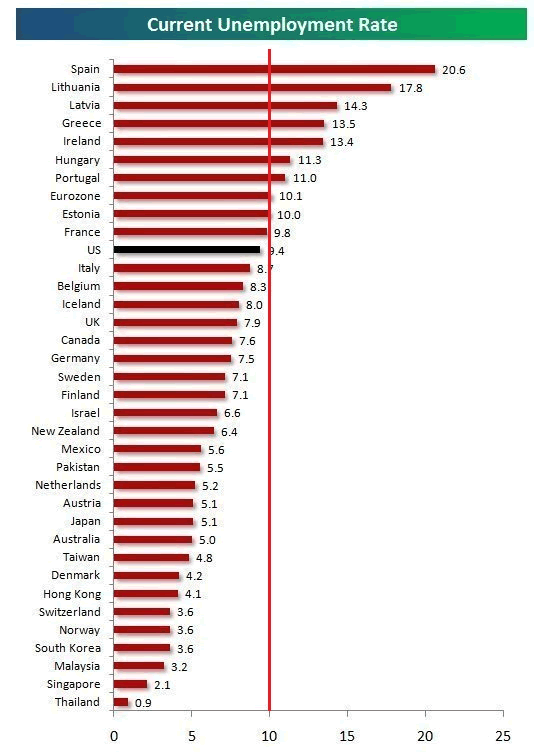
So what is the unemployment situation in the Arab League nations?
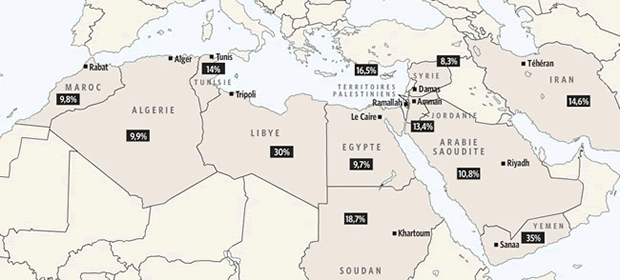
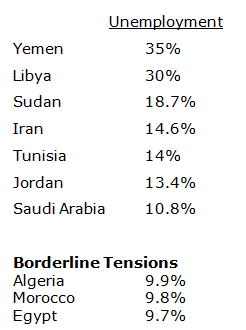
Now consider the percentage of the population below the age of 25 years old. This is the generation looking to enter the work force, who are starting or have young families needing income, or are contemplating what their lifelong occupation will be.
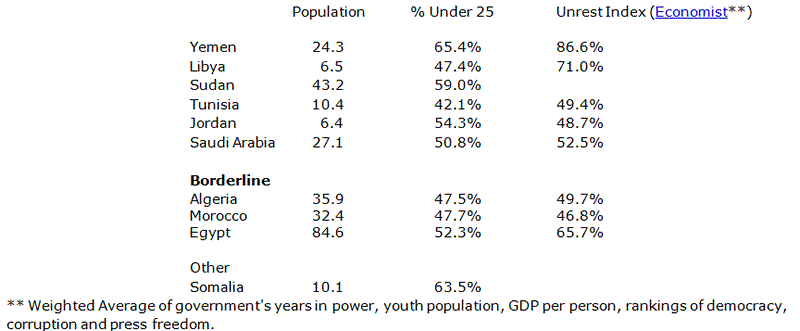
JOBS, FRUSTRATIONS & BEING ABLE TO EXIST
Frustrated and angry is the best way to describe the situation the above statistics foster - a situation ripe for a spark to set it off.
Forget the spin that every country wants to put on these protest events:
United States and EU: "This is a pro-democracy movement!!!" Iran: "This is an Islamic revolution!!" China: "These are riots instigated by minorities!!!" Russia: "This is a protest against America!!!"
It is really about being able to exist.
It is about unemployment, rising prices and the ability to make a person's life better for their family.
Call it social inequality, low personal income levels, corruption or whatever. None of this incites the masses until they are hungry, worried about their families' future and have nothing to lose.
As futurist Gerald Celente regularly says: "When people have nothing to lose, they lose it!"
HIDDEN SUBSIDIES
I believe the root of the Arab problem is their relatively small GDP growth in relation to their population growth compounded by food inflation that can no longer be affordably subsidized by the government.
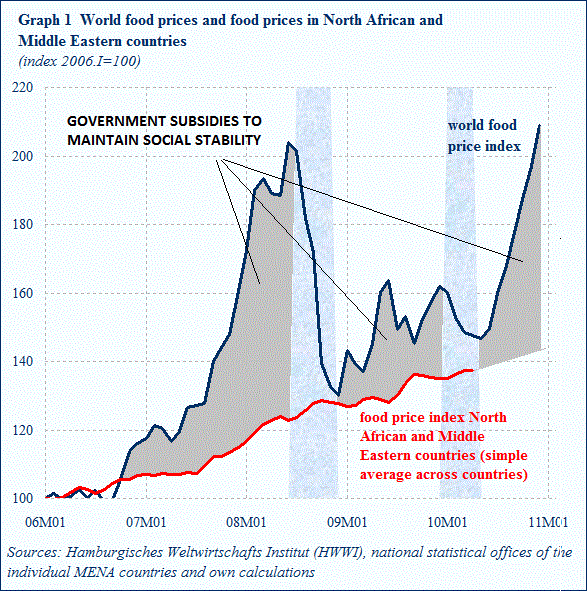
According to the above chart, over a 5 year period since January 2006, food has compounded at over 6.5% annually on average in North Africa and the Middle East. Like a vice grip, every year tightening further and placing increasing pressures on families. 2011 is not reported in the above chart, but the UN announced food prices were up 2.2% in February following 8 consecutive monthly increases.
The hidden issue is the difference between the countries' food price index increases and actual import food price increases. The difference is what the government is absorbing as subsidies to contain rebellion because of unaffordable food costs.
The levels of subsidies as shown below is staggering, with Egypt projecting 26.2% in 2010 alone. What happens when governments can no longer keep up with food price increases? Perfectly predictable massive social unrest. A few well place insurgence and you topple governments.
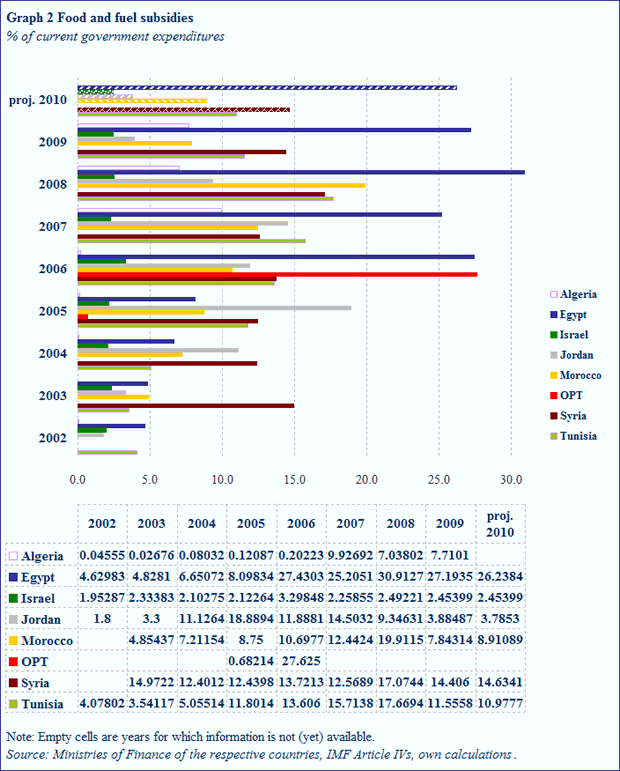
THE US 'INTERNATIONAL AID' CHARADE
Western citizens would likely react by saying: 'but this is why we have foreign aid, to help countries in need'. That may very well be the perception, but the facts when it comes to the Arab League nations, does not bear that out.
What the chart below shows is that the aid given is very targeted and the vast amount is spent on military needs. In other words, it is money paid out to be military proxies in the region for US foreign policy. This is why Mubarak was able to stay in power for three decades.

Between 1945 and 1975, the US strategy in the region has been determined by the desire to ensure control over the vast oil reserves, then by the objective of forcing payment for oil in "paper-" dollars, that's to say, a dollar free of any fixed parity with gold. This double objective was achieved in the 1980s.
In 2011, the whole structure is collapsing under the battering of the Arab populations. Because, as regards oil, the real shock emanating from Tahrir Square that has been felt in Riyadh and in the oil monarchies of the region, is the discovery that the United States is not a reliable "bodyguard".
In practical terms, as local reactions show for that matter, the Egyptian crisis and the lack of US support for Mubarak, has initiated a 'behind the scenes' review process of the entire relationship with Washington, including the dependence of these countries' leaders on military trained and equipped by the United States.
The end of cheap oil, or more exactly of the indirect control of oil prices through the protection afforded to the oil monarchies, has apparently arrived.
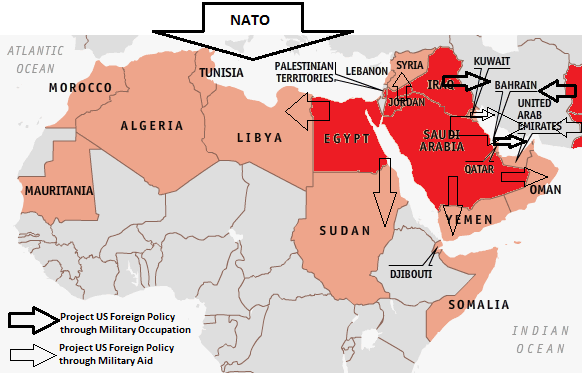
 In my concluding article to the Extend and Pretend series: Stage I Comes to an End! in July 2010, I warned of a US False Flag event specifically coming in the Middle East. As I see pictures of the massive amphibious assault ship USS Kearsarge now off the coast of Libya and headlines of a possible US invasion of Libya, I am reminded of what I wrote in July 2010.
In my concluding article to the Extend and Pretend series: Stage I Comes to an End! in July 2010, I warned of a US False Flag event specifically coming in the Middle East. As I see pictures of the massive amphibious assault ship USS Kearsarge now off the coast of Libya and headlines of a possible US invasion of Libya, I am reminded of what I wrote in July 2010.
"Looking forward, now that all of Europe is gripped in austerity, (and make no mistake - this very same austerity is coming to the US on very short notice with crashing popularity ratings for all political parties), has the political G-8/20 elite focused a little too much on a 'Falkland War'? Is war precisely the diversion that Europe and soon America hope to use in order to deflect anger from policies such as ....
Is there a Gallup or some other polling "unpopularity" threshold that the G-20 is waiting for before letting loose all those aircraft carriers recently parked [1] next to the Persian Gulf, the Israeli jets in Saudi Arabia [2] or the recent US troop buildup [3] on the Iran border? [4]"
Picture Above Right: " Defense Secretary Gates just announced that two amphibious US assault ships were loaded and bound to Libya." - Business Insider

Sign Up for the free 2011 Thesis Paper: Beggar-thy-Neighbor at Tipping Points
Sign Up for the Currency Wars series of articles at: Commentary
Gordon T Long gtlong@comcast.net Web: Tipping Points Mr. Long is a former executive with IBM & Motorola, a principle in a high tech start-up and founder of a private Venture Capital fund. He is presently involved in Private Equity Placements Internationally in addition to proprietary trading that involves the development & application of Chaos Theory and Mandelbrot Generator algorithms.
Gordon T Long is not a registered advisor and does not give investment advice. His comments are an expression of opinion only and should not be construed in any manner whatsoever as recommendations to buy or sell a stock, option, future, bond, commodity or any other financial instrument at any time. While he believes his statements to be true, they always depend on the reliability of his own credible sources. Of course, he recommends that you consult with a qualified investment advisor, one licensed by appropriate regulatory agencies in your legal jurisdiction, before making any investment decisions, and barring that, we encourage you confirm the facts on your own before making important investment commitments.
© Copyright 2010 Gordon T Long. The information herein was obtained from sources which Mr. Long believes reliable, but he does not guarantee its accuracy. None of the information, advertisements, website links, or any opinions expressed constitutes a solicitation of the purchase or sale of any securities or commodities. Please note that Mr. Long may already have invested or may from time to time invest in securities that are recommended or otherwise covered on this website. Mr. Long does not intend to disclose the extent of any current holdings or future transactions with respect to any particular security. You should consider this possibility before investing in any security based upon statements and information contained in any report, post, comment or recommendation you receive from him.
© 2005-2022 http://www.MarketOracle.co.uk - The Market Oracle is a FREE Daily Financial Markets Analysis & Forecasting online publication.



